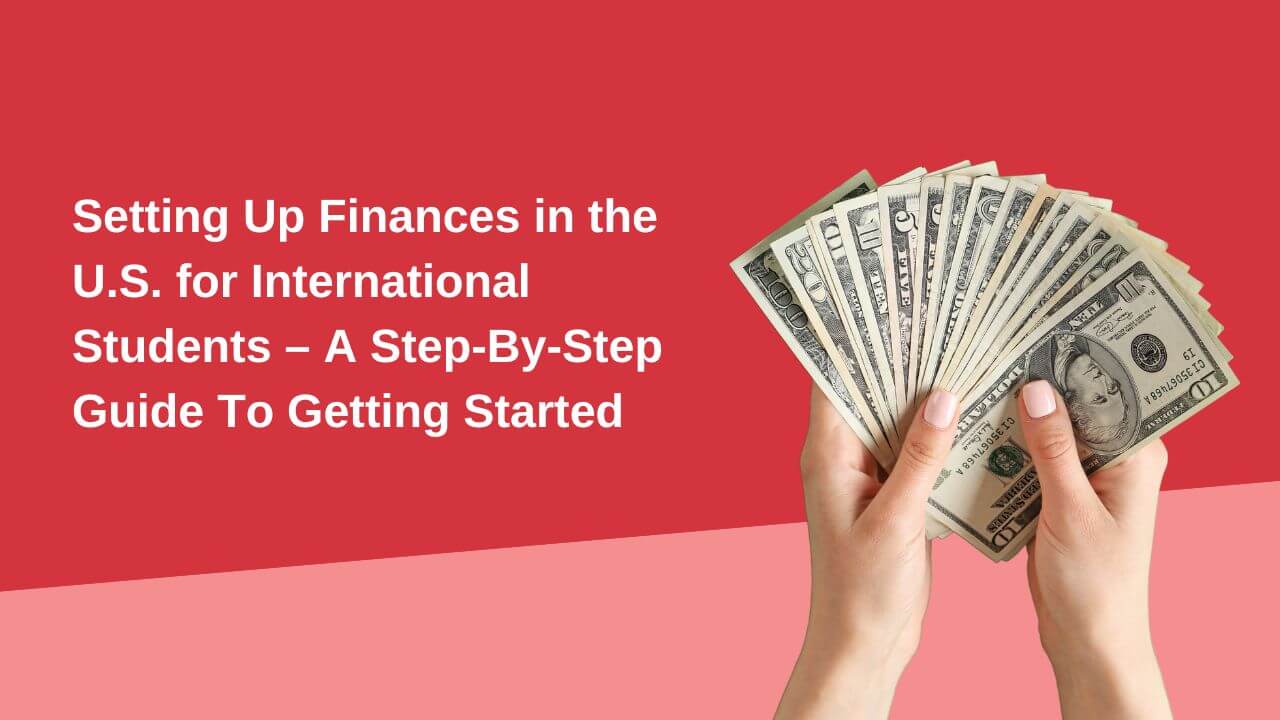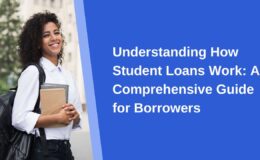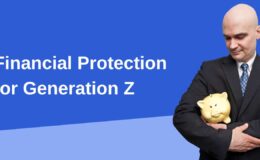Coming To The USA
Each year the USA issues more than 300,000 F1 student visas. If you are looking to study abroad and earn the benefits of international education, be it a bachelor’s degree or a master’s degree, or even a Ph.D., the USA offers one of the best educational opportunities for an international student. Studying in the US is an exciting experience. There are so many new things to see and do. But before you can enjoy your time here, you need to take care of some practical matters – like setting up your finances.
As an international student, you will need to open savings and checking bank accounts, get a credit card, and figure out how to pay your bills. This can seem like a lot, but don’t worry – we’re here to help.
This guide will walk you through each of the steps so that you can quickly and easily be set up for financial success in the USA.

Step 1: Opening A Bank Account
One of the first things you will need to do when you arrive in the US is open a bank account. This will give you a place to deposit your money and access it when you need it.
There are many different banks to choose from, so it’s important to do some research and find one that meets your needs. Some things you may want to consider are:
- Fees: What kinds of fees does the bank charge?
- Minimum balance: Does the bank require a minimum balance?
- Interest rates: What interest rate does the bank offer on savings accounts?
To open a bank account, you will need to bring some identification with you, such as your passport and student ID. Make sure you understand what your bank requires before starting the process. The bank may also require that you have a Social Security Number (SSN) or an Individual Taxpayer Identification Number (ITIN). As an international student, you can still get a Social Security Number; please click here to learn more on how to get your SSN.
Typically, a person will want at least one checking and one saving account with the same bank. A savings account is a place where you can deposit money and earn interest on it. A checking account is a place where you can deposit money and write checks to pay your bills.
If you want to learn more about savings and checking accounts, check out our articles – What Is A Savings Account And How Does It Work? and What Is A Checking Account And How Does It Work?
As international students, transportation may be difficult to go to an in-person bank. For this reason, we recommend that you consider online banks, such as Quontic Bank, or Axos Bank.
Quontic Bank
Quontic Bank offers a number of advantages to international students, including online access and removing common bank fees such as overdraft fees. Additionally, they offer high-interest returns in both their checking and savings accounts, to help your money grow.
High-Interest Checking
Quontic boasts a 3-minute ultra-fast setup time and a low $100 minimum deposit for their high-interest checking accounts.
Key Features:
- Earn 1.10% APY on all balances
- Open an account online in just 3 minutes
- No monthly maintenance fees or minimums
- $100 minimum deposit required to open an account
It is important to note that you will need to make 10 debit card point-of-sale transactions of $10 or more per statement cycle required to earn the maximum APY (Annual Percentage Yield) per account balance tier. If the qualifying activity requirement is NOT fulfilled, the interest rate paid on the entire balance will be 0.10% APY. Please visit our website for a list of non-qualifying activities.
You can easily do this by buying groceries or meals with your Quontic debit card!
High Yield Savings
Similar to their high-interest checking accounts, Quontic offers a 3-minute fast setup and low $100 minimum deposits for high-yield savings accounts with high yields of 4.25%
Key Features:
- Earn 4.25% APY with a Quontic High Yield Savings Account
- Start earning interest from Day 1 of your first deposit with no limit on how much you can earn.
- Open an account online in just 3 minutes
- Interest is compounded daily and credited to your account every month
Similar to other banks, Quontic sets a limit of 6 withdrawals per statement cycle.
For this reason, we recommend you have a savings account to store the majority of your money, and move what you need for the month over to a checking account once or twice a month to spend it.
Axos Bank
Another online banking option is Axos Bank, which Forbes calls “one of the top online banks.” With quality savings and checking account services, Axos is a great option for international students to get started in the US. Axos offers multiple tiers of checking and savings accounts. Each option is tailored to specific needs. Here are our top recommendations for you.
Essential Checking
Axos Essential Checking offers a no-fee 100% online checking account option. If you want direct deposit from employers and free ATM usage, this is a great account for you.
Key Features:
- No monthly fees
- Unlimited ATM fee reimbursements
- Early direct deposit
- Referral bonus when you invite friends
- 100% mobile and online banking
Axos Bank Cashback Checking
Axos offers a Cashback Checking account that requires only a $50 deposit to open. With up to a 1.25% APY (annual percent yield) and ATM fee reimbursement, this is a great first checking account.
Key Features:
- No monthly maintenance fees
- 15 minutes to set up
- Unlimited domestic ATM fee reimbursement
- Up to 1% cashback on signature-based purchases
- Only $50 to open an account
High Yield Savings
A High Yield Savings account is a great account for college students, featuring a high APY and a bank card.
Key Features:
- Earn up to 0.61% APY*
- Free ATM card upon request
- Suite of digital money management tools
- No maintenance fees
- No monthly minimum balance requirements
- $250 minimum balance to open an account
Now that you have a bank account set up to store your money, you are ready to set up your methods of spending it!
Step 2: Setting Up Payment Methods

Once you have a bank account to store your money, you will need to set up methods of accessing that money to pay for things. From groceries to transportation, most day-to-day expenses are no longer cash-based. There are three main methods of payment: credit cards, payment apps, and checkbooks.
Credit Cards/Debit Cards
A credit card/debit card is a plastic card that can be used to make purchases or withdrawals. In order to get a credit card, you will need to open a credit card account with a bank or other financial institution.
Background:
A credit card allows you to purchase on a loan and then repay the money at the end of the month or over time. If you use a credit card, you will typically have more rewards and protection from fraud, though it is important to always pay your balance at the end of the month or there are high fees.
A debit card is linked directly to your bank account. It pulls money directly from your account, so you will not owe fees on unpaid balances, but they typically offer less protection and have fewer rewards.
You can get a debit card when you set up your bank account, though we recommend that you only use it at known locations and get a credit card to protect you and give you rewards such as cash back when you spend.
Choosing A Credit Card:
There are many different types of credit cards, so it’s important to choose one that meets your needs. Some things you may want to consider are:
- Annual fee: Does the credit card have an annual fee?
- Interest rate: What is the interest rate on the credit card?
- Rewards: Does the credit card offer rewards, such as cashback or points that can be redeemed for travel or other purchases?
Coming to the US, you may not have a credit score yet.
Credit scores are a rating of your ability to pay back loans based on past experiences. People with better credit scores (~750+) can get access to better credit cards with lower interest rates and more rewards. When you apply for a credit card, your score will be checked and will decrease slightly because credit checks temporarily decrease credit scores.
If you are starting out, we recommend looking for a student card, or credit building card, which will increase your odds of approval and help you increase your credit score. Some even let you pre-pay your card so that there is little risk of owing money.
Reputable companies to check out include Chase, Discover, Capital One, and Apple. With so many credit cards to choose from and varying credit scores of our readers, we highly recommend using Credit Karma to ease your decision-making.
Credit Karma is a free service that will allow you to check your credit score without decreasing your rating and recommend credit cards that you can apply for. It will even show you your odds of approval for each card so that you can apply for the best cards you can reasonably get.
I personally use Credit Karma to check my credit score and to find my credit cards. I highly recommend you check them out.
NOTE
At this point, I will continue to discuss other useful financial services that you may want to consider. You do not need these services to get started in America, but they are commonly used and useful. Also check out our article – Credit Card Debt: How It Works And Why You Want To Avoid It.
Payment Apps
There are many different payment apps available, such as Venmo and CashApp. These apps allow you to send and receive money from others. They can be used to pay bills or make purchases.
Typically payment apps can be linked to your credit card or even your checking account. There are often fees associated with linking to credit cards, so be wary of this.
Usually, different areas of the country have different preferences on which app to use. I would recommend asking friends at your school which one they prefer.
Venmo
Venmo is a service that links to your bank account and will allow you to pay your friends from your phone. This is great for splitting bills and paying back rent. I personally use Venmo to pay my friends back for everything from food and rides to concert tickets.
Cash App
Cash App is a direct competitor of Venmo and is used for the same purposes. The choice of app tends to fall to personal preference. I have friends who prefer Cash App and others who use Venmo. Some even use both.
Check Books
A checkbook is a small book that contains blank checks. Checks can be used to pay bills or make purchases. In order to get a checkbook, you will need to open a checking account with a bank.
Most of the time you will not use checks. The only regular use of checks that you may encounter is rent payments, though most rent is paid online now.
If you are interested in getting checks, you can contact your bank or use a company like Extra Value Checks, which will let you personalize your checks with custom images.
You’re All Set Up!
Now that you have set up a bank account and gotten a credit card, and possibly even set up other payment methods, you will be able to access your money easily here in the USA. As an international student, you may need help with figuring out housing and food as well as the technology that you will need for school.
Check out our step-by-step guides here:
- Housing, Food, and Transportation: What international students need to know when they come to the US
- International Student Technology: A guide to everything from phones to internet access
Lastly, despite the camaraderie that you find with the students from the same country, it is suggested that you mingle with the local students from the diverse student body that the US offers, get to know the local culture, and understand and accept the cultural differences. Also, be a part of the This helps you widen your world point of view while at the same time developing lifelong relationships.
As an international student, it is important that you don’t do anything that violates your visa status. You are advised to keep checking the guidelines of immigration regulations on the website of U.S. Citizenship and Immigration Services( a government agency under the US Department of Homeland Security) to make sure you don’t violate them unknowingly as any violation is taken seriously and often leads to deportation. refer to the website https://www.uscis.gov/ for more detailed information.
If you are all set up and want to learn more about personal finance, check out our course here!







